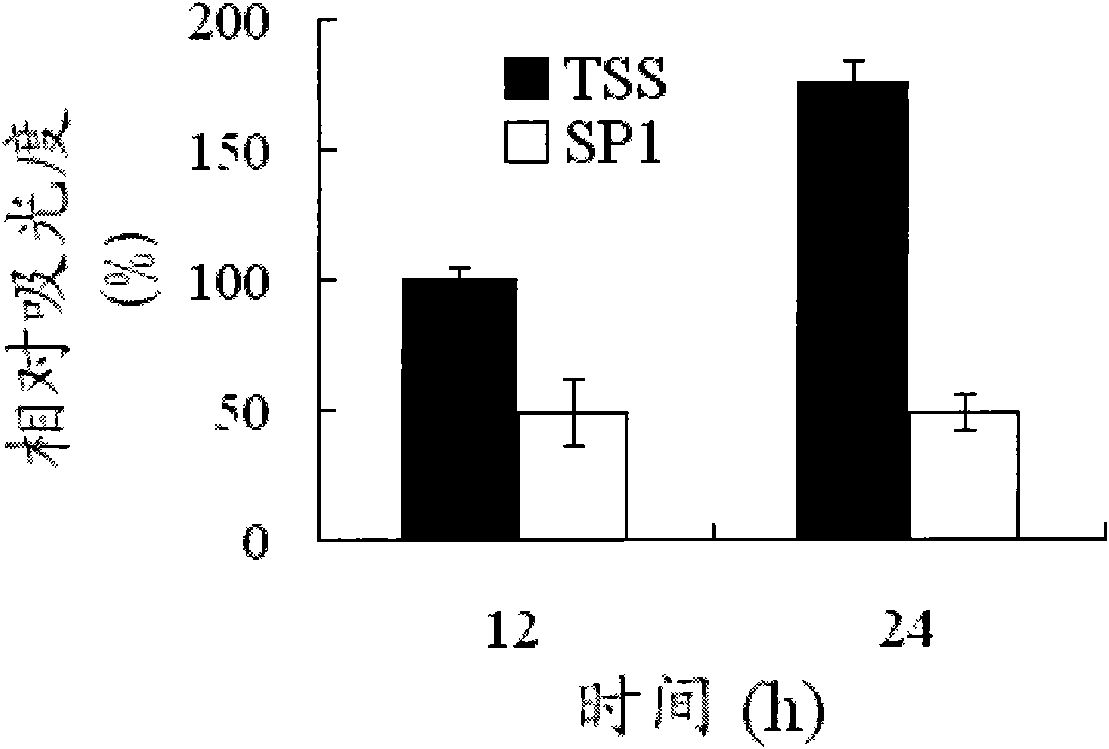Bacterium for reducing mercury pollution in seawater and application thereof
A technology for mercury pollution and seawater, applied in the direction of water pollutants, bacteria, water/sewage treatment, etc., to achieve rapid removal and high safety effects
- Summary
- Abstract
- Description
- Claims
- Application Information
AI Technical Summary
Problems solved by technology
Method used
Image
Examples
Embodiment 1
[0023] Screening of strains with higher resistance to mercury compounds and identification of 16S rRNA strains.
[0024] Collect the bottom mud from Yantai sea area, and apply it on the surface containing 5ppm HgCl 2 In the solid medium of 28 ~ 30 ° C incubator for 36 hours, the clones that form colonies on the plate are the clones that are resistant to HgCl 2 resistant colonies. Prepare different concentrations of HgCl 2 solution, the bacteria were measured for HgCl 2 The MIC value of the resistance is 80ppm, which belongs to HgCl 2 Bacteria with high resistance. The bacterium was named Pseudomonasputida (SP1). The genomic DNA of the strain was extracted, and its 16S rRNA was amplified by PCR with 8F (AGAGTTTGATCCTGGCTCAG) and 1492R (GGTTACCTTGTTACG ACTT) for identification. The conditions of PCR were: denaturation at 94°C for 4 min, denaturation at 94°C for 30 s, annealing at 57°C for 1 min, extension at 72°C for 1 min, starting from the second step, 30 cycles. PCR pr...
Embodiment 2
[0029] PCR cloning of the mer operon associated with SP1 mercury resistance.
[0030]SP1 has the characteristic of actively resisting mercury, indicating that there are resistance genes related to bacterial mercury resistance in vivo. We designed primers to clone the mer operon gene of SP1 according to the sequence of the mer operon of the gene related to bacterial mercury resistance that has been reported. A total of 3 pairs of primers were designed for PCR. Primer F1 (TAAGACTGCTGCTGGTAGTGGGTG) / R2 (GCGAGCCGCTTAGGGATTGTAT), PCR conditions: 94°C pre-denaturation for 4 minutes, 94°C denaturation for 30 seconds, 55°C annealing for 1 minute, 72°C extension for 3 minutes, starting from the second step, 30 cycles. Primer F2 (TGCTGCCTCTGTTTGCTGGACT) / R3 (GCCCGATACCGGACTCAAAGG), PCR conditions: 94°C pre-denaturation for 4 minutes, 94°C denaturation for 30 seconds, 57°C annealing for 1 minute, 72°C extension for 3 minutes, starting from the second step, 30 cycles. Primer merCF1(CATATGG...
Embodiment 3
[0099] Resistance of SP1 to other heavy metals and antibiotics.
[0100] To determine the resistance of SP1 to other heavy metals and antibiotics, the following heavy metals and antibiotics were used to test: CdCl 2 、CoCl 2 , CrCl 3 , CuCl 2 , PbCl 2 , ZnSO 4 And ampicillin (Ap), kanamycin (Kn), chloramphenicol (Cm), tetracycline (Tc). SP1 in the final concentrations of 0.1mM, 0.5mM, 1mM, 5mM, 10mM heavy metals and 20ug / ml, 40ug / ml, 60ug / ml, 100ug / ml, 200ug / ml, 300ug / ml, 400ug / ml antibiotics After culturing in 2216E medium at 28-30°C for 24 hours, observe the growth of SP1, and take the maximum concentration of heavy metals and antibiotics at which bacteria can grow significantly as the minimum inhibitory concentration of heavy metals and antibiotics on SP1. The results are shown in Table 1. SP1 can survive in an environment containing high concentrations of heavy metals and antibiotics, indicating that SP1 has a strong ability to adapt to the environment and can survive...
PUM
 Login to View More
Login to View More Abstract
Description
Claims
Application Information
 Login to View More
Login to View More - R&D
- Intellectual Property
- Life Sciences
- Materials
- Tech Scout
- Unparalleled Data Quality
- Higher Quality Content
- 60% Fewer Hallucinations
Browse by: Latest US Patents, China's latest patents, Technical Efficacy Thesaurus, Application Domain, Technology Topic, Popular Technical Reports.
© 2025 PatSnap. All rights reserved.Legal|Privacy policy|Modern Slavery Act Transparency Statement|Sitemap|About US| Contact US: help@patsnap.com



